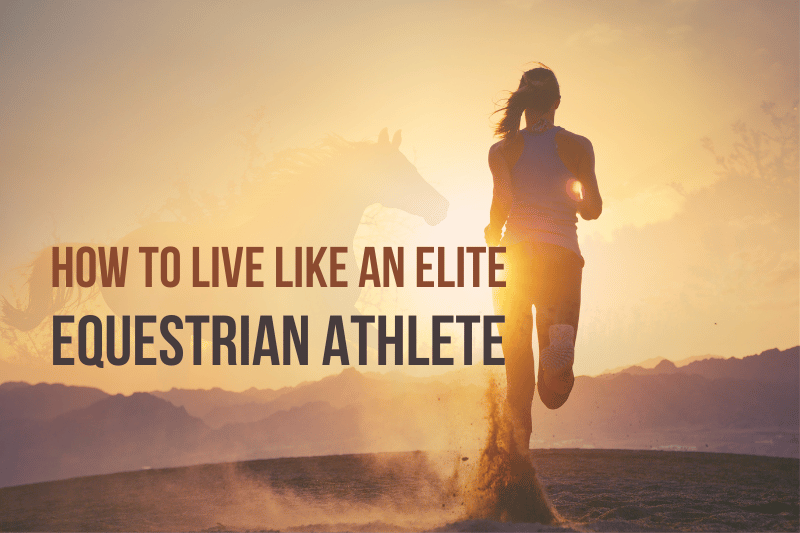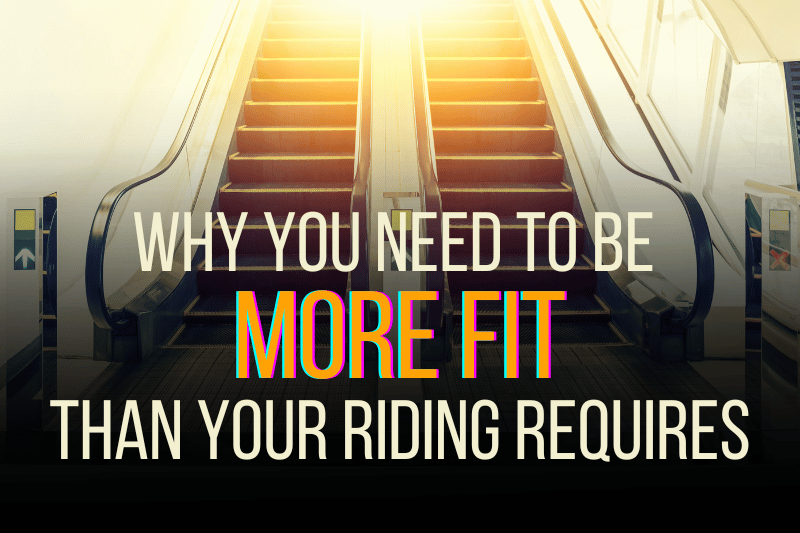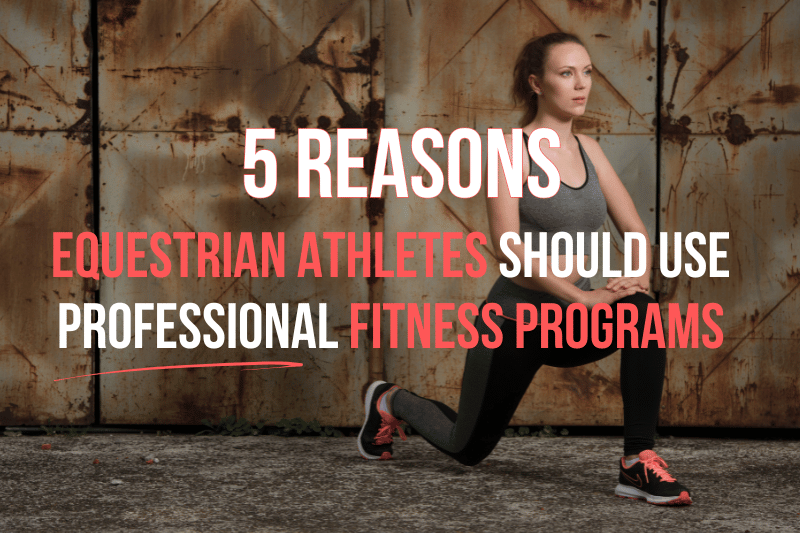Most riders aren’t elite competitors, but we can still benefit from a commitment to rider fitness. What does that lifestyle look like, and what do we stand to gain from living like an elite equestrian athlete?
What is an Elite Equestrian Athlete?
An elite equestrian athlete is more than a skilled rider. She hones her primary skills, of course. She works with a riding coach, learns from sitting a variety of horses, and competes regularly.
But what does she do out of the saddle to maximize her success in it? I guarantee she does more than muck stalls and schlep a few feed bags.
An elite equestrian athlete achieves exceptional physical performance relative to her peers. Let’s consider what that looks like in the real world.
Exceptional Rider Fitness for the 99%
I’m also in my mid-forties. Some of you call that young and, relatively speaking, you may be right. But before any of us adopt age as an excuse, let’s not forget:
- Gulhild Swanson, a female runner who finished the Western States 100-mile trail run in 2015 at age 71
- Wally Hesseltine, a runner who finished Western States in 2022 at age 72 (Yes, that’s the Tevis trail…on foot!)
- Harriette Thompson, who set age records when she finished a marathon at 92 and a half-marathon at 94
- Ernestine Shepherd, a female competitive bodybuilder at age 79
- Andrea Owen, 2018 Spartan World Champion in her age group at age 57
- Shaun Havard, who won her age group in the 2018 Crossfit Games at age 62
- Sister Madonna Buder, aka the Iron Nun, who completed a full Ironman triathlon in 2012, at age 82
I could continue down that inspiring rabbit hole for days, but you get the idea. Imagine all the older athletes out there who didn’t make the news, but were also out there being amazing!
Back to my situation: Happily, I enjoy athletics and bring some experience to the table. My partner is supportive. I can commit about 2 hours per day to fitness, plus another hour to preparing healthful meals. My lifestyle permits frequent movement, desk job notwithstanding, and prioritization of sleep.
The upshot is that any races I happen to win (unlikely) will be on horseback. But that isn’t going to stop me from maximizing my potential as as equestrian athlete.
Characteristics of an Elite Equestrian Athlete
What does an elite athlete actually do? How does she think, and what actions does she choose? What are the unique benefits of fitness for equestrians? Let’s explore.
Commitment to Cross-Training
All serious athletes cross-train. Runners also cycle. Swimmers also run. Cyclists also swim. All of them lift weights.
Why would serious equestrians be any different?
Like any sport, riding emphasizes certain movements and ignores others, leading to tension and imbalance. Incorporating other athletic activities goes a long way to correct this. Additionally, cross-training is widely recognized as crucial for increasing endurance and power, building strength, improving flexibility, and reducing risk of overtraining and injury. Ignore it, and you’re leaving money on the table.
Cross-training is uniquely beneficial for equestrians. Not only do we gain the usual improvements in strength, power, and reduced risk of injury, but we also gain empathy.
Consider: We routinely ask our horses to perform extraordinary physical feats. When we push our own bodies through cross-training, we gain the ability to understand ~ not just intellectually, but viscerally ~ what real effort feels like.
That alone is worth the price of admission.
But, there’s more. The improvement cross-training elicits in our own body composition, balance, strength, and mobility translates readily into improved equitation. It also enhances lifespan, healthspan, and quality of life.
Living like an elite equestrian athlete means placing high value on cross-training. I’ll make time for it.
Intentionality
Intentionality is what distinguishes athletes from exercisers.
Anyone can get some physical and mental benefit from doing their obligatory 150 minutes per week of “exercise,” but an athlete has her eye on something more. An athlete comes to each workout with purpose.
It might be a long run in Zone 2 to build endurance or hill repeats to improve VO2 max. It might be box jumps for power or heavy backsquats for strength. It might be a hike and yoga to bring nourishment and flexibility to recovering muscles.
Whatever it is, the equestrian athlete understands why she’s doing a particular workout on a particular day.
And, she’s certainly not going to be doing the same workout a year from now. She’ll be doing more. “It never get easier,” they say. “You just get better.”
Equestrian athletes track their performance over time. They strive for growth. They don’t just do something. They do something specific, for a specific reason, and they always try do it better.
I ask this of my horses. Why wouldn’t I ask it of myself?
Having Goals & Using Processes
Elite equestrian athletes have big goals ~ whatever “big” looks like in the context of their personal reality.
Having a goal is motivating for most people. Achieving it is a massive reward. But elite athletes don’t spend all their time daydreaming about finishing Tevis or qualifying for the Olympics. They spend it on the process.
I already know how my process will look on a monthly, weekly, and daily basis. I know when I’ll begin distance training cycles and that I’ll focus on speed and strength in-between. I have a routine that ensures my weeks and days are mapped to accommodate my plan. I trust that when I focus my energy on one, clear step at a time, my goals will take care of themselves.
If feel like skipping the gym, I ask myself, “What would an elite equestrian athlete do?”
The answer is clear: An elite equestrian athlete would do the work.
Doing the Work of an Equestrian Athlete
We equestrians put in a lot of saddle time. As challenging a skill as riding is, however, it generally isn’t as physically taxing as good cross-training. At least, not if we’re cross-training like elites.
Like other athletes, riders benefit most from using well-designed fitness programs. There’s magical about equestrian-specific workout plans, though they can be helpful as long as the aren’t too easy for you. Look for something that will enable you to master a level and move on. For recommendations, check out 5 Reasons Equestrian Athletes Should Use Professional Fitness Programs.
Cross-training workouts typically fall into a couple, familiar buckets: cardiovascular training and strength training. Top athletes ~ including equestrians ~ don’t ignore either.
Cardiovascular Training
Cardiovascular fitness is endlessly useful. As an endurance rider, I value the ability to dismount and run down a long hill beside my horse. He can easily recover on the move, I get to shake out stiff muscles, and we sometimes pass a surprising number of teams in the process.
I also find it comforting that I could hike many miles out of a bad situation. With or without my horse, I can explore parts of the world that the unfit will never see. Plus, general rider fitness makes everything from trimming hooves to fixing fence easier.
Most people will get optimal results from spending 80% of their cardio time at around 75% of their maximum heart rate, and the remaining 20% at 80-95% of max heart rate.
Note: This means you’ll have to do more than go for a walk at lunch.
Running is often the most accessible choice. If you struggle with orthopedic issues, you might want to consider cycling or swimming. For beginners nervous about getting hurt, a good medical practitioner, physical therapist, health coach, or personal trainer should be able to help you identify an appropriate program.
Strength Training
Strength training is at least as important as cardio, and arguably more so.
Sarcopenia (muscle loss) begins around middle age and continues until we die. With muscle goes metabolism, stability, strength, and ability to do the things we love. The only way to combat sarcopenia is to strength train, consume plenty of protein, and supplement with creatine.
Equestrian sports are unusual in that riders can remain competitive into their sixth decades and beyond. A choice not to strength train is a choice to age out of riding sooner than you need to.
Start now. Taking action before middle age will give you a bigger “bank account” to draw on later. Taking up strength training in middle and old age will dramatically slow the rate of muscle loss. Check out Why You Need to Be More Fit than Your Riding Requires.
Of course, strength training is beneficial in the short term, as well. If you frequently ache after riding, you might be surprised how much of that disappears in the context of a good strength training program. Plus, building muscle will speed your metabolism to keep you lean without counting calories.
How to get started strength training is a post for another day, but here’s a good program that’s gradual enough to be safe, yet hard enough to be effective. Don’t forget to move up when you’re ready.
Elite equestrian athletes lift heavy. (Goodbye, 2-lb pink dumbbells. We don’t love you anymore.)
Upping Your Game as an Equestrian Athlete
Ignore those popular media stories that say you can achieve optimal health by walking 30 minutes per day. If you’re taking care of horses, you probably already do that…but are you getting elite results?
No? I didn’t think so.
You have to do more. You have to push your limits, whatever they may be. Don’t press 65 pounds if you could do 80. When you’re comfortable jogging 12-minute miles, shoot for 11:30. Elite athletes don’t phone in their workouts. They work.
Get strong enough to squat your bodyweight. Learn to run on tired legs. Feel your lungs burn for breath. Get comfortable with being uncomfortable.
You’ve felt your horse’s pulse drum through his body. Now, it’s your turn.
Supporting the Work of an Equestrian Athlete
Ah, the flip side: Recovery.
Elite equestrian athletes constantly stress their systems and structures just enough to make them build back a little stronger. That rebuilding can only happen with appropriate support.
Mobility
All elite athletes eventually learn to put the time into mobility work, even though it’s rarely as sexy as their sport of choice.
As equestrians, we experience repetitive motion, the criticality of balance and symmetry, and occasional traumatic injury. Keeping our joints limber and fascia smooth goes a long way toward keeping us ~ and our mounts ~ feeling our best.
I certainly perform better at both riding and cross-training when I include foam rolling, yoga, and MAPS Prime in my daily routine. Still, mobility work is the easiest component for me to brush off.
I ask again: What would an elite athlete do?
Fuel
No elite athlete can perform without high octane fuel.
Nutrition works just like engines or education or anything else. Put crap in, and you’ll get crap out. Don’t put enough in, and you won’t get enough out. You have to feed your performance.
We endurance riders frequently spend race days in a state of dehydration, calorie deficit, and electrolyte depletion. I’m told this is common at shows in other disciplines as well. Obviously, this has a way of making events less fun and more risky for everyone.
Learning to fuel like athletes in our daily lives ~ because we are athletes in our daily lives ~ prepares us to do so in competition. Good fueling habits become second nature. We come to events will well-nourished bodies, able to support our horses over long hours of work.
Sleep
You don’t need me to remind you that science continues to emphasize the importance of adequate, quality sleep for health and longevity. It’s even more important under the demands of an elite athletic lifestyle.
Don’t call me after 9 p.m., kids. Lights out.
Positivity
When I think of my favorite elite athletes, it’s not their physiques that comes to mind. It’s not their achievements, either.
It’s their attitudes.
A true elite is the athlete you cheer for because she believes not only in herself, but in life. In you. She wants to win, but she builds others up along the way.
She builds herself up, too.
Give yourself a mental high five for a tough workout in the books. When you fail, use the chunks of your broken dreams as stepping stones. Reach back to help others over the wall.
Find a way to smile through the mud and sweat, the broken stirrup leather, the soaked boots from a stumble in the creek. It really is about how you play the game.
An elite equestrian athlete isn’t always the best. She isn’t always even her best. But she always tries.
And so will I.
Further reading: In Happy Brain, Happy Gut, Happy Rider, I share how a marathon coach’s advice applies to endurance riders.
You might also like
This page includes affiliate links, and I may earn a small commission (at no extra cost to you) when you purchase through these links. I only recommend products and services I think are helpful and useful. Thanks for helping me offset the cost of maintaining this blog as a free resource!







This is so inspiring and exactly what I was looking for. I want to be an equestrian athlete and I’m not fit … yet 😉
I’m excited to be on this journey with you!
Yessssss!!! So glad to have you along for the ride! 😀 😀 😀
This is truly a well-rounded and beautifully written article with a strong message. I will be off reading your other posts! Thank you for sharing your view with the equestrian world.